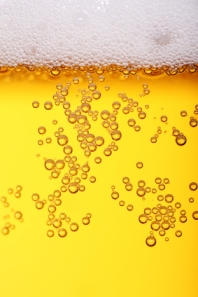by
Aeration Explained
Lets start with some basic definitions. Aeration is the injection of oxygen into the wort during the brewing process, usually after boiling and cooling cooling and just prior to fermentation. The act of boiling wort forces most of the oxygen out of solution. Unfortunately, as we covered in our article on fermentation and the yeast life cycle, yeast requires a great deal of oxygen during the “lag phase” when it is rapidly multiplying in the wort. Without enough oxygen, the yeast will fail to reproduce sufficiently, leaving an incomplete fermentation.Before we get to how to best add more oxygen, lets look at two other important terms. Another term you may hear is “hot side aeration”, which refers to exessive splashing or aeration of the wort during the boil or before we’ve had a chance to cool the wort down. The problem with adding oxygen while the wort is hot is that it can oxidize the melanoidins in your beer leading to a stale flavor. A study by the late George Fix suggests that hot side aeration can occur at temperatures as low as 86F (which is pretty low!), so it is important to cool your wort before aerating it.
A third term, called oxidation is closely related to the first two. Oxidation occurs when you add oxygen after the lag phase of yeast growth (i.e. later in fermentation, or after the beer has fermented). In this case, the effect is exactly what is seen when you left your pony keg at college out for a few days with an air pump on it. The air oxidizes the finished beer, leaving a strong stale flavor. So you clearly don’t want to introduce oxygen in your beer after lag fermentation has started.
Aerating your Wort
So far we’ve learned that hot side aeration is bad, oxidation is bad, but proper aeration of the cooled wort is good. Now lets look at how to put this information to good use in our beer. Yeast needs between 8 and 10 parts per million (ppm) of oxygen to properly reproduce in the lag phase. A level of 8ppm is achievable using air alone (which is 21% oxygen), but achieving a higher level requires a tank of pure oxygen.The best time to aerate your wort is as soon as it is cool. Ideally this can be done during transfer to the fermenter or immediately after transfer to the fermenter. If you aerate after pitching your wort, do not aerate for long as the lag phase generally starts withing a few hours of pitching the wort.
There are three basic methods for aerating wort:
- Splashing – Splashing the wort around in the fermenter can actually add some oxygen to the solution. You can achieve the same effect by splashing the wort around during transfer – for example using a cap at the end of the siphon that splashes the wort out the side a bit. While splashing will not achieve as high an oxygen content as injection, it is a good option for those on a limited budget. Splashing is far superior to no aeration at all.
- Agitation –Agitation is done by stirring rapidly with a spoon, whisking the wort around with a wisk or rocking the entire fermenter. Generally a sterilized whisk is best if you have open access to the wort. Whisk the beer vigorously for several minutes before adding your yeast. Agitation is a step above splashing, as it generally gets more oxygen into the solution.
- Injection – There are many ways to inject air or oxygen directly into the wort. The simplest setup involves using an inexpensive aquarium pump with a inline sterile filter. Note that the filter is needed to prevent bacteria and other organisms from being drawn in with the air. I also recommend using some kind of carbonation stone or aeration stone at the end of the tube to help diffuse the air. Care must be taken to sanitize the stone and tube before using it. A more elaborate injection system would use an actual oxygen bottle and regulator to inject oxygen. However, even the relatively cheap aquarium pump injection system can achieve the 8 ppm ideal aeration level needed for your wort.
http://beersmith.com/blog/2010/01/19/aeration-for-home-brewing-beer/

No comments:
Post a Comment